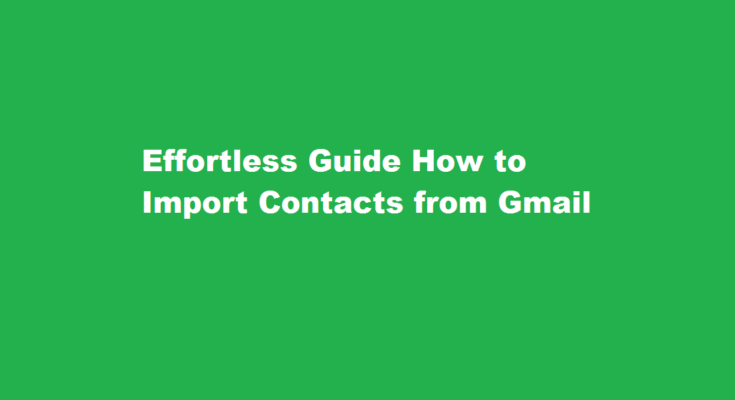Introduction
Managing contacts is essential for maintaining professional and personal connections. Gmail, being a popular email service, offers a convenient way to store contacts. This article will provide you with a step-by-step guide on how to import contacts from Gmail, enabling you to streamline your communication and ensure you never lose touch with important individuals.
Exporting Gmail Contacts
Before importing your contacts, you need to export them from your Gmail account. Here’s how
- Open your Gmail account and click on the “Google Apps” button (represented by nine dots in a square) in the upper-right corner.
- From the apps menu, select “Contacts.” This will open the Contacts interface.
- In the Contacts interface, click on “More” and then choose “Export.”
- A window will appear, allowing you to choose the contacts you wish to export. Select the desired contacts or choose “All Contacts” for a complete export.
- Next, select the export format. The recommended format is “Google CSV,” which can be easily imported into other platforms.
- Click on the “Export” button, choose a location to save the file, and click “Save.”
Importing Gmail Contacts to Other Platforms
Now that you have exported your Gmail contacts, let’s explore how you can import them into other platforms such as email clients, CRM software, or mobile devices
Importing to Microsoft Outlook
- Open Microsoft Outlook and go to the “File” tab.
- Under the “Open & Export” category, select “Import/Export.”
- In the Import and Export Wizard, choose “Import from another program or file” and click “Next.”
- Select “Comma Separated Values” and click “Next.”
- Browse to locate the exported CSV file and choose how to handle duplicates. Then, click “Next.”
- Select the destination folder in Outlook where you want to import the contacts and click “Next.”
- Finally, click “Finish” to complete the import process.
Importing to Apple Contacts (macOS and iOS)
- On your Mac, open the Contacts application. On iOS, go to the “Settings” app and select “Contacts.”
- In the Contacts application, select “File” and choose “Import.”
- Locate and select the exported CSV file, and click “Open.”
- The contacts will be imported, and you can now access them through your Apple Contacts on all your connected devices.
Importing Gmail Contacts to Google Contacts
If you prefer to manage your contacts within Google’s ecosystem, importing your Gmail contacts into Google Contacts is a straightforward process
- Open Google Contacts on your computer by visiting contacts.google.com.
- In Google Contacts, click on the “Import” button on the left-hand side menu.
- A file selection window will appear. Choose the exported CSV file and click “Open.”
- Google Contacts will process the file and import the contacts into your account. You will receive a confirmation once the import is complete.
FREQUENTLY ASKED QUESTIONS
How many contacts can I import?
As a side note, Google only lets you import 3000 contacts at a time. If you’re migrating to Google from another system (say, Outlook) and you want to export your contacts in a .
What format is Gmail contacts importing?
To transfer contacts between Google accounts, use the Google CSV format. This is the recommended way to back up your Google Contacts.
Conclusion
Effectively managing your contacts is crucial for maintaining productive relationships. By learning how to import contacts from Gmail, you can seamlessly transfer your contacts to other platforms or consolidate them within Google’s ecosystem. Whether you prefer using Microsoft Outlook, Apple Contacts, or Google Contacts, the step-by-step instructions provided in this article empower you to effortlessly import your Gmail contacts. Take advantage of these simple procedures to streamline your communication, ensure contact consistency across platforms, and never miss a beat with your connections.
Read Also : Mastering The Art of Music Mixing A Comprehensive Guide



